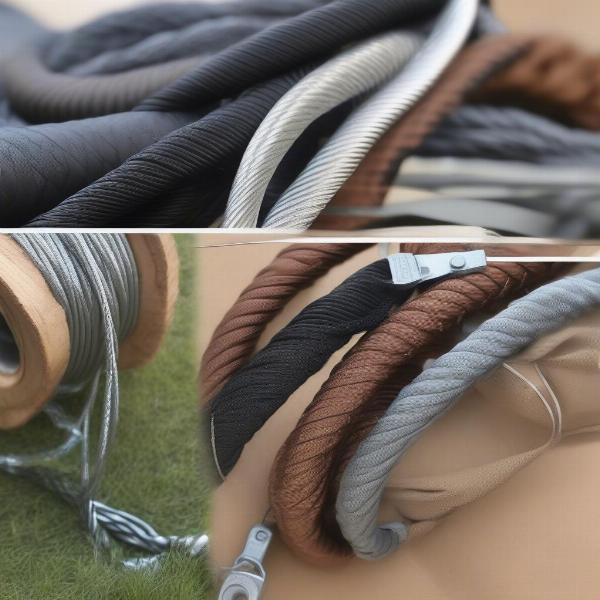Tie out cables for dogs offer a convenient way to give your furry friend some outdoor freedom while maintaining a safe and controlled environment. However, choosing the right tie out cable and using it responsibly is crucial for your dog’s well-being. This guide will delve into the essential aspects of using tie out cables for dogs, covering everything from selecting the appropriate cable to ensuring your dog’s safety and comfort.
Choosing the Right Tie Out Cable
Selecting the correct tie out cable is paramount for your dog’s safety and comfort. Consider your dog’s size, breed, and temperament when making your decision. A cable designed for a small dog won’t be suitable for a larger, more powerful breed. Similarly, a lightweight cable might not withstand the strength of a dog that tends to pull or lunge.
Material and Construction
Look for tie out cables made from durable, weather-resistant materials like galvanized steel or coated aircraft cable. Avoid cheap materials that can rust, fray, or break easily. Check for secure clasps and swivels to prevent tangling and ensure the cable remains functional over time.
 Dog Tie Out Cable Materials
Dog Tie Out Cable Materials
Length and Weight
The length of the tie out cable should provide enough space for your dog to move around comfortably without reaching potential hazards like roads or fences. However, excessively long cables can become tangled or allow your dog to wander too far. Choose a weight appropriate for your dog’s size and strength.
Trolley Systems vs. Stakes
Consider whether a trolley system or a stake is more suitable for your needs. Trolley systems allow your dog to move along a designated line, while stakes provide a fixed point of attachment. Each option has its advantages and disadvantages, so choose the one that best fits your dog’s personality and your outdoor space.
Safe and Responsible Use of Tie Out Cables
While tie out cables offer convenience, responsible usage is vital for your dog’s safety and well-being. Never leave your dog unattended on a tie out for extended periods, as this can lead to boredom, frustration, and potential dangers.
Supervision and Time Limits
Always supervise your dog while they are on a tie out cable. Limit tie out time to short periods and provide plenty of opportunities for interaction and play. Regularly check the cable for signs of wear and tear and replace it immediately if any damage is found.
Providing for Basic Needs
Ensure your dog has access to fresh water and shade while on a tie out. Consider providing a comfortable resting area, especially during warmer weather.
Avoiding Potential Hazards
Carefully inspect the area where your dog will be tied out to identify and eliminate potential hazards like sharp objects, toxic plants, or gaps in fences. Ensure the cable is attached securely to a sturdy object that won’t easily be pulled over or dislodged.
Alternatives to Tie Out Cables
While tie out cables can be useful in certain situations, they should not be a primary means of confinement or exercise. Consider alternatives like fenced yards, supervised playtime, or regular walks to provide your dog with the physical activity and mental stimulation they need.
Conclusion
Tie out cables can be a helpful tool for dog owners, providing a safe and controlled way for dogs to enjoy the outdoors. However, responsible usage, careful selection, and regular monitoring are essential. By prioritizing your dog’s safety and well-being, you can ensure that using a tie out cable is a positive experience for both you and your furry friend. Remember to always choose a high-quality tie out cable that suits your dog’s size and needs and use it responsibly to prevent accidents and ensure your dog’s comfort.
FAQ
-
How long can I leave my dog on a tie out cable? Tie out time should be limited to short periods under supervision. Avoid leaving your dog unattended for extended periods.
-
What material is best for a dog tie out cable? Durable, weather-resistant materials like galvanized steel or coated aircraft cable are recommended.
-
What length of tie out cable should I use? The ideal length provides enough space for movement without reaching hazards. Consider your dog’s size and the environment.
-
Are there alternatives to tie out cables? Yes, fenced yards, supervised playtime, and regular walks are preferable alternatives.
-
Can I use a tie out cable for training? Tie out cables are not ideal for training. Consult a professional dog trainer for effective training methods.
-
What should I do if my dog’s tie out cable breaks? Replace it immediately with a new, high-quality cable. Inspect the area for any hazards your dog might have encountered.
-
How can I prevent my dog’s tie out cable from tangling? Use a cable with a swivel and ensure the surrounding area is free of obstacles that could cause tangling.
ILM Dog is a leading international online resource dedicated to providing expert advice on dog care and upbringing. We offer valuable insights into dog breeds, health, training, nutrition, grooming, activities, puppy care, senior dog care, travel tips, and product recommendations. Whether you’re a seasoned dog owner or just starting your journey, ILM Dog is here to help you navigate every aspect of dog ownership. Contact us at [email protected] or +44 20-3965-8624 for personalized guidance. Visit us at ILM Dog for more expert advice and resources.